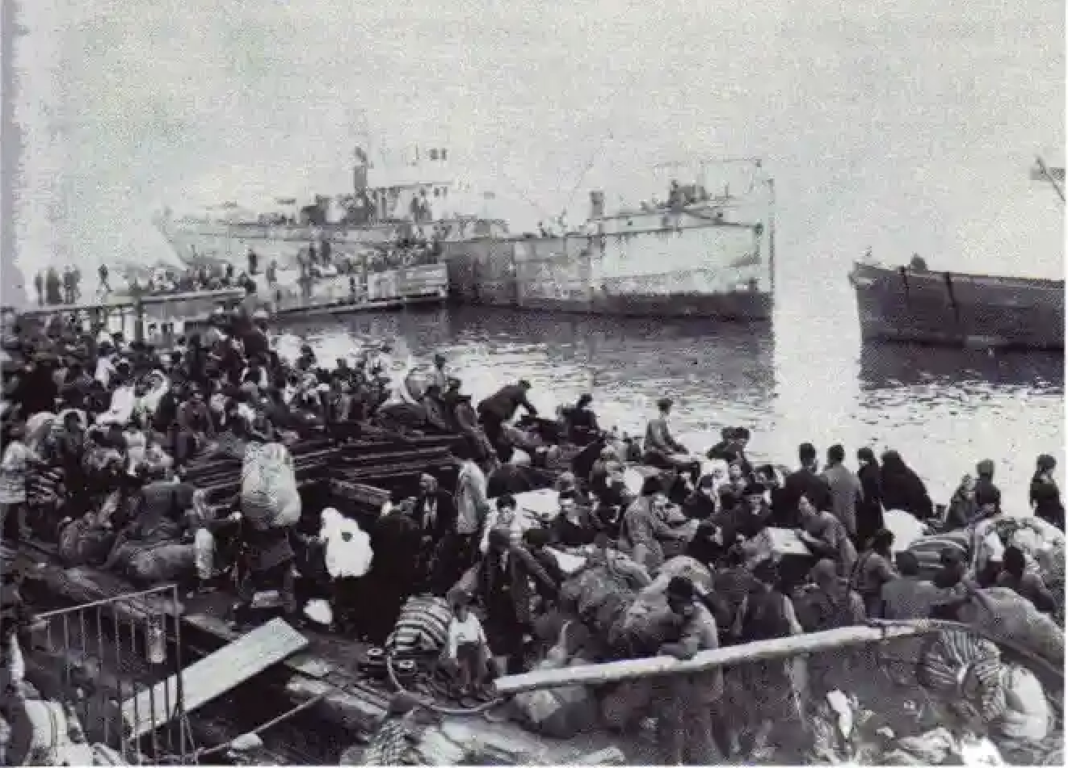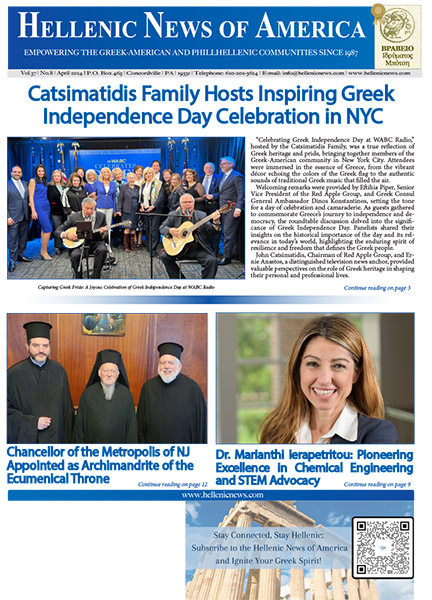In September 2022, we commemorate the 100-year anniversary of the culmination of the Asia Minor Catastrophe with the burning of the great center of Smyrna. What occurred with the burning of Smyrna and the slaughter of the defenseless Greek Orthodox Christians of Smyrna was the epitome of a systematic persecution that cannot be termed anything other than Genocide. This was a Genocide that began in 1894 against the Greek Orthodox and other Christian populations of the Ottoman Empire and sadly continued with the birth of modern Turkey and the Kemalist state. This Genocide followed centuries of overt and covert persecution of Greek Orthodox Christians that sadly existed under the Turkish yoke since the Fall of Constantinople in 1453.
What followed the burning of Smyrna in 1922 was the forced exchange of populations from the entirety of Asia Minor, the uprooting of Greek Orthodox Christians from a land that, since ancient times, for 3000 years, flourished as a bastion of Hellenism, a land that then became a citadel of baptized, Christianized Hellenism, a land that was a fortress of Romiosini, of Romanity, a land that was and still is another Holy Land for Orthodox Christianity as a whole. A Genocide had occurred, a Genocide unrecognized by some, a Genocide ignored by others, a Genocide unaware to others.
On the Sunday before the Feast of the Exaltation of the Holy Cross (September 14), the Church has dedicated the day in honor of the Martyred Bishops of this time period of the Asia Minor Genocide: Saint Chrysostomos, the Metropolitan Bishop of Smyrna, Saint Ambrose, Metropolitan of Moschonisia, Saint Prokopios, Metropolitan of Iconium, Saint Gregory, Metropolitan of Kydonia, and Saint Euthymios, Metropolitan of Zilon.
When given the option of leaving Smyrna multiple times by Western diplomats, Saint Chrysostomos refused to leave, saying he must stay with his flock of Christians. Given over to an angry Turkish mob which shaved off his beard as a sign of great disrespect, Saint Chrysostomos was beaten, had parts of his body cut off, and his eyes gouged out. His holy body was never found. He was burned together with the city of Smyrna, not given even a proper burial by his persecutors.
Saint Ambrose of Moschonisia meanwhile was buried alive with nine priests in a pit outside Kydonia. Saint Prokopios of Iconium faced enormous, unimaginable pressures from the Turkish government. Saint Gregory of Kydonia was tortured horribly in prison and killed with other priests and notable Greeks in Kydonia, refusing also to abandon his flock and managing to bring thousands of his flock to the island of Mytilene for refuge. Saint Euthymios of Zelon was also tortured in prison, where he died and gave his soul into the hands of our Lord.
This blood-soaked, crucified Asia Minor, through her clergy and laity, breathes the spirit of “joyful sorrow,” of harmolipi (χαρμολύπη), of a Cross-Resurrectional spirit (σταυροαναστάσιμο πνεύμα) that is otherworldly, of a kingdom not of this world, of crucified yet enduring, trusting in the power of the Resurrection of Christ and looking to a hope that lies beyond this senseless, illogical, temporary and often times evil-ridden world.
As inheritors of a tremendous legacy of Asia Minor, how do we modern Greeks cherish the example, the witness, and the martyrdom of our heroic ancestors of Orthodox Faith and Hellenic heritage, our ancestors by blood and by spirit? How do we honor their memory? How do we imitate their example?
What an amazing legacy the Greek Orthodox Christians of Asia Minor leave us! What a legacy of a people who have provided us for generations upon generations centers of Orthodox Christianity, centers of Ecumenical Councils, and countless Martyrs, Ascetics, Fathers, and other Saints of the Church – men and women, young and old, rich and poor, educated and uneducated: yet all simple, yet all humble, yet all faithful, yet all pious, yet all God-fearing, yet all loving, yet all hospitable, yet all prayerful, yet all disciplined, yet all patient, yet all ascetical.
How do we honor the memory and legacy of the Christians in a land that witnessed the missionary journeys of the great Apostle to the Nations Saint Paul?
How do we honor the memory and legacy of the Christians in a land that was blessed with Epistles that are part of the New Testament: Epistles to the Ephesians, Epistles to Saint Timothy, the Bishop of Ephesus, Epistles to the Colossians, to the Galatians, to St. Philemon?
How do we honor the memory and legacy of the Christians in the land that witnessed the activity of Saint John the Theologian in Ephesus, that witnessed the work of other Apostles of the Twelve?
How do we honor the memory and legacy of the Christians in the land that witnessed the presence of the Panagia?
How do honor the memory and legacy of the Christians of Smyrna, Philadelphia, and Tralles to whom Saint Ignatios the Godbearer of Antioch, who was the little child whom Christ held in His arms in the Gospel, wrote Epistles?
How do we honor the memory and the legacy of Saint Antipas, Bishop of Pergamon, mentioned in the Book of Revelation of Saint John the Theologian?
How do we honor the memory and legacy of Saints Boukoulos, the disciple of Saint John the Theologian and first Bishop of Smyrna, and the aged Polycarp, Bishop of Smyrna, Saint Boukoulos’ successor, who went to martyrdom, refusing to blaspheme His King and Savior Jesus Christ?
How do we honor the memory and legacy of Saints like the Great Martyrs George (with roots from Cappadocia), Anastasia of Cappadocia, Kyriake and Panteleimon of Nicomedia, Marina of Cilicia, Euphemia of Chalcedon, Theodore the Tiron of Pontos, and Theodore the Commander of Galatia?
How do we honor the memory and legacy of Martyrs like Christopher of Lycia, Tryphon of Lampsacus, Julitta and her son the 3 year old Kyrikos of Iconium, the Holy 40 Martyrs of Sebastia in Pontos, and the 20,000 Martyrs of Nicomedia who were killed while attending Liturgy on Christmas Day?
How do we honor the memory and the legacy of the pair of Holy Unmercenaries (the Agioi Anargyroi, Άγιοι Ανάργυροι) Kosmas and Damian?
How do we honor the memory and the legacy of the great Fathers and Saints of the Church like Saint Nicholas, Archbishop of Myra in Lycia, the Wonderworker, Saint Stylianos of Paphlagonia, Saint Basil the Great of Cappadocia together with his family, Saint Gregory the Theologian of Cappadocia together with his family, and Saint John Chrysostom, who died in exile in Comana of Pontos?
How do we honor the memory and the legacy of the great monastic Saints Theodosios the Cenobiarch and Saint Savas the Sanctified of Cappadocia (both of whom are deeply connected with monasteries of the Holy Land under the Patriarchate of Jerusalem) and Saint Irene Chrysovalantou, the great miracle-worker, of Cappadocia?
How do we honor the memory and legacy of Saint Mark Eugenikos, the Metropolitan of Ephesus, the lion who refused a false union with the Roman Catholic world on the eve of the Fall of Constantinople to the Turks?
How do we honor the memory and legacy of all the New Martyrs and Confessors of the Faith under the Turkish Yoke, including those of the Asia Minor Genocide?
How do we honor the memory and legacy of the refugees, the 20th century Saints who fled to a free Greece due to the Genocide, Saints Arsenios the Cappadocian and Paisios the Athonite, both of whom were uprooted and exiled from Farasa of Cappadocia? How do we honor Saint Iakovos Tsalikis, a patron of the island of Evia, who had fled with his family from Levisi of Asia Minor, opposite the island of Rhodes, at two years old?
How do we honor the memory and legacy of Saint John the Russian, a slave who shared the common lot of our Greek ancestors, whose relics from Prokopi of Asia Minor were transferred to the island of Evia to an area known as New Prokopi? This is Saint John whose miracles are many, whose powerful intercessions were seen even during recent wildfires on the island.
How do we honor the memory and legacy of the Christians who were blessed for centuries with the miraculous icon of Panagia Soumela of Saint Luke the Evangelist, which is a spiritual treasure and solace from the blood-soaked land of Pontos, to Vermion in northern Greece?
I answer the above questions by asking the following series of questions for all of us to ponder:
Do we honor the legacy of Asia Minor by driving out or ignoring the Orthodox Christian life that was their very heartbeat? It was considered by our ancestors that, to abandon the Greek Orthodox Faith, one would become Turkish. So closely did they associate their Faith with their ethnic heritage and their daily lives.
Do we honor the legacy of Asia Minor by advocating for the removal of the Cross from the Greek flag and the removal of icons from public places and classrooms in Greece?
Do we honor the legacy of Asia Minor by advocating and demanding from people to not kiss the holy icons and the holy relics of the Saints for fear of catching a disease, when so many Saints from Asia Minor gave their very blood for venerating and kissing these same icons?
Do we honor the legacy of Asia Minor by advocating for multiple, disposable Communion spoons (lavithes) for fear of catching a disease through Holy Communion?
Do we honor the legacy of Asia Minor by cursing Christ, Panagia, and the Saints with our words?
Do we honor the legacy of Asia Minor by partying hard, enjoying our times at bars and cafes- until the very late hours of the night- while not being able to even step foot in a church or go to a church service (whether morning or evening)?
Do we honor the legacy of Asia Minor when we can never stay for the Liturgy on Pascha? Is it honoring the legacy of Asia Minor by rushing out after the chanting of “Christ is risen”? All the while, are we even aware that, under the Turks, due to lack of priests as a result of persecution and martyrdom, certain areas did not always have a priest in order to even have a Pascha Liturgy?
Do we honor the legacy of Asia Minor by not keeping Sunday as the Lord’s Day? Do we honor the legacy of Asia Minor by not observing the feasts of Christ, Panagia, and the major Saints during the liturgical calendar year?
Do we honor the legacy of Asia Minor by writing off the fasts of the church as outdated and not for us? At one point in time, it was considered by some of our ancestors, in their simplicity, that it was “Turkish” not to fast. Nowadays, is it that we all know better and we know everything, supposedly, that we ignore fasting?
Do we honor the legacy of Asia Minor by wearing the matakia, the little eyes, to ward off the evil eye? The Turks used to rip the crosses off our ancestors and put the matakia on them instead. These matakia the Turks would put on their livestock, sending the message that the Orthodox were livestock. Yet, wearing the little matakia to ward off the evil eye is one of the fads and rages of our days.
May the memory of all the victims of the burning of Smyrna and the Asia Minor Genocide be eternal! May we learn and appreciate our history so we do not forget what truly matters in life and so that we can spiritually progress.






